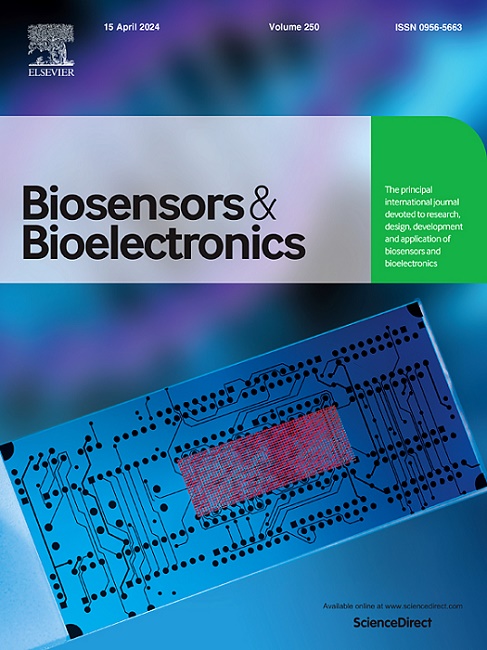CuS@Ag Heterostructure-based Surface Plasmonic Coupling Electrochemiluminescence Sensor for Glioma miRNA-124-3p Detection
IF 10.7
1区 生物学
Q1 BIOPHYSICS
引用次数: 0
Abstract
As an emerging class of extended crystalline organic materials, covalent organic framework (COF)-based aggregation-induced emission luminogen (AIE-gen) exhibited encouraging emissive properties. In this work, 4’,4’’,4‴,4‴’-(1,1,2,2-Ethenetetrayl)tetra(4-biphenylcarbaldehyde) (ETBC) as AIEgen was used to prepare AIE-COF (ET-COF-COOH) luminescent nanoprobe. ETBC and 1,3,5-Tris(4-aminophenyl)benzene (TAPB) had an extended π electronic system that allowed electron delocalization and overlapping transport. Because AIEgen-ETBC served as the luminescence center of ET-COF-COOH, the ET-COF-COOH possessed an ideal anodic electrochemiluminescence (ECL) performance. Moreover, due to the surface plasmonic coupling (SPC) effect of the CuS@Ag square-cavity array, the ECL signal of ET-COF-COOH was amplified as 2.8 times. The AIE-COF/CuS@Ag SCH array-based SPC-ECL sensor was used to detect miRNA-124-3p with a wide range of 1 fM-10 nM and LOD of 0.49 fM. Furthermore, the proposed biosensor can effectively distinguish between tumor tissue and adjacent tissue and offer significant potential for advancing glioma diagnosis.
求助全文
约1分钟内获得全文
求助全文
来源期刊

Biosensors and Bioelectronics
工程技术-电化学
CiteScore
20.80
自引率
7.10%
发文量
1006
审稿时长
29 days
期刊介绍:
Biosensors & Bioelectronics, along with its open access companion journal Biosensors & Bioelectronics: X, is the leading international publication in the field of biosensors and bioelectronics. It covers research, design, development, and application of biosensors, which are analytical devices incorporating biological materials with physicochemical transducers. These devices, including sensors, DNA chips, electronic noses, and lab-on-a-chip, produce digital signals proportional to specific analytes. Examples include immunosensors and enzyme-based biosensors, applied in various fields such as medicine, environmental monitoring, and food industry. The journal also focuses on molecular and supramolecular structures for enhancing device performance.
 求助内容:
求助内容: 应助结果提醒方式:
应助结果提醒方式:


